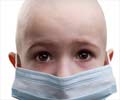Global Burden of Childhood Cancer: Children with cancer lost more than 11 million years of healthy life worldwide in 2017, reports a new study.

- Study is first analysis to quantify the impact of childhood cancer in terms of years of healthy life lost to ill-health and premature death
- Collectively, childhood cancers are the 6th biggest contributor to total cancer burden worldwide after adult cancers of the lung, liver, stomach, colon, and breast; and the 9th leading cause of childhood disease burden globally
- India, China, Nigeria, Pakistan, Indonesia, and the USA face the largest burden of childhood cancer among countries with the highest population of children
- Lack of diagnosis and access to healthcare and a younger population are responsible for disproportionately large childhood cancer burden in many of the poorest countries
While the number of new cancer cases in children and adolescents (aged 0-19 years) is relatively low at around 416,500 globally in 2017, treatment-related ill-health and disability and fatal cancer are estimated to cause around 11.5 million years of healthy life lost globally every year, according to the first Global Burden of Disease Study (GBD) to assess childhood and adolescent cancer burden in 195 countries in 2017.
‘Childhood cancers have resulted in 11 million years of healthy life lost worldwide in 2017. Therefore, early diagnosis and treatment could save lives and also help reduce the global burden of childhood cancers.’
Read More..




Children in the poorest countries face a disproportionately high cancer burden--contributing over 82% of the global childhood cancer burden--equivalent to almost 9.5 million years of healthy life lost in 2017. Most (97%) of this global burden is related to premature death, with around 3% due to impaired quality of life.Read More..
For the first time, researchers provide a complete picture of the global and regional burden of childhood cancer beyond incidence, mortality, and survival. The study estimates the number of years of healthy life that children and adolescents with cancer have lost due to illness, disability, and premature death--a measurement known as disability-adjusted life years (DALYs). One DALY is equivalent to one year of healthy life lost. However, disability in childhood cancer survivors was limited to the first 10 years after cancer diagnosis, rather than across the whole life course, so the global burden of DALYs associated with childhood cancer is probably underestimated, researchers say.
"By assessing the global burden of childhood cancer through the lens of disability-adjusted life-years, we can more comprehensively understand the devastating impact of cancer on children globally," says Dr Lisa Force from St Jude Children's Research Hospital in the USA, who led the research in collaboration with the Institute for Health Metrics and Evaluation.
"Our findings are an important first step in establishing that childhood cancer has a role in frameworks that address global oncology and global child health."
Children with cancer who live in high-income countries tend to have good survival, with around 80% surviving 5 years after diagnosis. But these improvements have not translated to most low- and middle-income countries (LMICs), where survival is approximately 35-40%, but some estimates suggest it could be as 20%. Around 90% of children at risk of developing cancer live in LMICs.
Advertisement
"Estimating the years of healthy life children have lost due to cancer allows policymakers to compare the lifelong implications of childhood cancer with other diseases, potentially helping them determine the most effective way to spend limited resources and identify high-impact cancer-control planning decisions."
Advertisement
The study reveals striking inequities in childhood cancer burden between high and low SDI countries (table). High and high-middle SDI countries accounted for about 35% (147,300) of new cases of childhood cancer in 2017, but only 18% of DALYs (around 2 million years of healthy life lost), whereas low-middle and low SDI countries with 38% of global incidence (159,600 new cases) accounted for 60% of DALYs (almost 7 million years of healthy life lost).
Moreover, the research finds that childhood cancers are a major cause of global disease burden compared with both adult cancers and other childhood diseases. In 2017, childhood cancers were the sixth leading cause of years of healthy life lost out of all cancers globally (11.5 million), only lower than the burden from adult cancers of the lung (41 million), liver (21 million), stomach (19 million), colon (19 million), and breast (18 million). In low and middle SDI countries, childhood cancers were the leading cause of DALYs, higher than the burden attributable to any single adult cancer type.
The study puts the annual toll of childhood cancer at over 11.5 million years of healthy life lost in 2017. This compares with around 37 million years of healthy life lost globally due to malaria, and 7.6 million from tuberculosis (figure 6B). In 2017, childhood cancer was among the top four biggest contributors to the burden of general diseases of childhood in middle and high-middle SDI countries, ranking higher than malaria and HIV/AIDS.
While four of the five countries with the highest childhood cancer burden were in Asia and Oceania (India, China, Pakistan, and Indonesia), the USA had the sixth-largest burden in 2017, and sub-Saharan Africa had the biggest DALY burden for more childhood cancer types than any other region.
Cancers of the blood (leukemias) were the main contributors to overall DALYs, accounting for 34% of the total childhood cancer burden worldwide, followed by brain and nervous system cancers (18%). In 2017, the proportion of both leukemia and brain cancer burden differed by almost 3 times between regions. The proportional burden of leukemias was highest in central and Andean Latin America (49% of all childhood cancers), and the greatest absolute burden was in south Asia (954,000 DALYs).
The authors highlight the fact that mechanisms for addressing the cancer burden in adults, which focus on risk-reduction strategies and screening interventions, are not as relevant to childhood cancers given that childhood cancers generally progress rapidly, are not amenable to screening programmes which aim to identify pre-cancerous growths, and are fatal without swift diagnosis and treatment. This emphasizes the crucial role early diagnosis and treatment will play in order to reduce the global burden of childhood cancer.
Despite these important findings, the methodology used to estimate childhood cancer burden has several limitations that need to be addressed, say the authors. While the study uses the best available data, predictions are constrained by a lack of high-quality cancer data, particularly in developing countries--highlighting the need to expand the quality and quantity of population-based cancer registration systems and to include data from pediatric-specific cancer registries. They also note that the current anatomical site-based system of reporting adult cancer leaves over 26% of the childhood cancer burden (3 million DALYs) linked to cancers that are uncategorized, a challenging category for policy, financial, and clinical decision making.
In an accompanying editorial, the editors of The Lancet Child & Adolescent Health journal write: "The universal language of data offers a substantial opportunity to those fighting the global burden of childhood cancer. Analysis of the DALY burden by the individual country and cancer subtype shows the significant need for investment in data capture. Quality data collection and standardized reporting are crucial early strides towards better care provision for children with cancer in LMICs. Capture of national childhood cancer data can guide investments in the training of specialists to ensure earlier diagnoses, providing equitable access to medicines, reducing deaths, and improving survivorship care and quality of life."
Writing in a linked Comment, Charles Stiller from Public Health England, UK, discusses what can be done to mitigate or even reduce the global burden of childhood and adolescent cancer. He writes: "Early diagnosis can bring substantial reduction in mortality and long-term morbidity. Although gains from early diagnosis should be greatest in lower-resource countries, where too many cases are diagnosed at a late stage, they should be felt even in affluent countries, notably for people with low-grade brain tumors, survivors of which bear a considerable burden of disability. For the benefits of early diagnosis to be fully realized worldwide, it must be accompanied by improved diagnostic and treatment facilities with universal access. International collaboration will be an essential component of the necessary capacity building. It is to be hoped that the present study will help to stimulate the necessary improvements, and future iterations can monitor their success."
Source-Eurekalert













